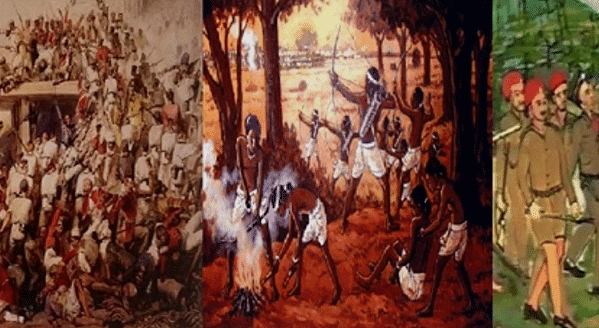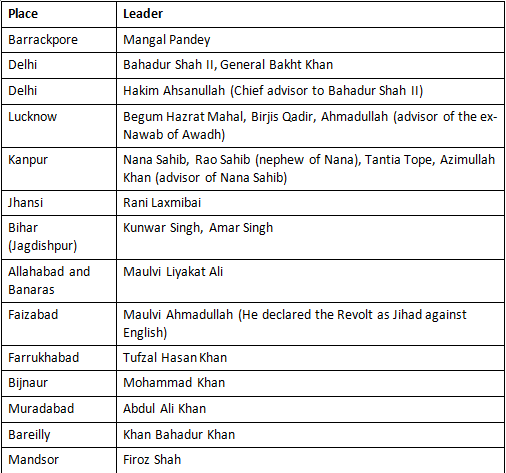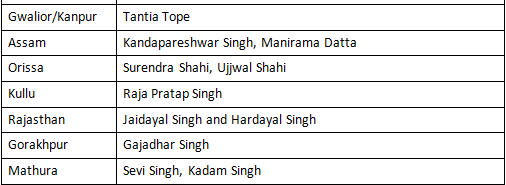NCERT Solutions for Class 12 History - (Part - 1) - Rebels and the Raj
Answer in 100-150 words
Q1: Why did the mutinous sepoys in many places turn to erstwhile rulers to provide leadership to the revolt?
Ans: Following are the major reasons to explain why the rebellious soldiers turned to native rulers for leadership:
(i) East India company defeated native rulers to grab power in India. Many believed that the native Indian rulers had the legal and legitimate authority to regain power in the respective kingdoms. Therefore, it was natural that they became the leaders of the rebels and regain the lost status of rulers.
(ii) The erstwhile rulers had substantial resources at their command. They had wealth and private armies too. The rebels waited to get the support of resources from them, and by declaring them the leaders it was natural outcome.
(iii) Most of the erstwhile Indian rulers were popular at the local level. Their subjects often sympathised with them as they believed that the latter were unlawfully thrown out of power and even suffered humiliation. Choosing these native rulers was echoing the sentiments of the people and winning more support for the cause.
Q2: Discuss the evidence that indicates planning and coordination on the part of the rebels.
Ans: The rebellion was not abrupt and sporadic but to a great extent done with planning and care. This is brought out by the following points:
(i) The rebels decided to strike when the large part of the British army was in Burma.
(ii) The time chosen for the rebellion was summer that is very hostile weather condition for the British. Summer was also the season when the entire countryside would be easy to navigate.
(iii) To spread the message of rebellion, the rebels used symbols bread and lotus from village to village.
(iv) Efforts were made to maintain Hindu-Moslem unity. Whenever an area would fail under rebel control, cow slaughter was banned.
Q3: Discuss the extent to which religious beliefs shaped the events of 1857.
Ans: People during the company rule felt that their religious sentiments are systemically hurt by the government. For them it was an attack on their religious freedom, and an insult. The religious causes for the Revolt are as follows:
(i) Immediate cause: The soldiers were given cartridge greased with cow and pig fat. This angered Moslems and Hindus alike.
(ii) Reforms by Company: The Company introduced many religious and social reformers. Many Indians began to believe that it was an attempt on the part the government to deviate them from their own religion. Important of such reforms were prevention of sati system, widow remarriage, etc.
(iii) Activities of Christian Missionaries: During company rule involved in spread of education. But local people looked upon them with suspicion. Thus, the people plunged in rebellion against the foreign rule.
Q4: What were the measures taken to ensure unity among the rebels?
Ans: A very important element of the revolt of 1857 was the unity shown by Hindus and Moslems in the struggle against the foreign rule. First the immediate cause of the rebellion was the use of cartridge greased with fat of cow and pig, angering Hindus and Moslems alike. After the rebels marched to Delhi, they declared the Mughal emperor Bahadurshah their all India leader. Thus, the Mughal emperor was the leader of Hindus and Muslems alike. Both Hindus and Muslims respected each others’ religious sentiments. Whenever a new area fell into the control of rebels, cow slaughter was made illegal to respect Hindu sentiments. Thus, Hindu-Muslim unity was the hallmark of the mutiny.
Q5: What steps did the British take to quell the uprising ?
Ans: In 1857 a sepoy mutiny broke out in East India that became a mass uprising in many parts of the country. The Company had faced rebellions in the past too, but not of this magnitude and extent. The British rulers realised that unless the rebellions is suppressed, their empire was destined to fizzle out.
They took swift measures to put down the flame of the rebellion, some were of military nature while others were of political nature.
The important measures taken by the British to suppress the rebellion are as follows:
(i) Imposition of Marshal Law and large scale of execution: In north India where rebels were holding ground, Marshal Law was imposed. Apart from enforcing law, military officers also had the power to dispense justice and pronounce conviction and punishment. Thus, for all practical purposes, rebels and their sympathizers could be declared guilty without fair trial. The punishment was not just swift, cruel and partisan but in most cases execution. The execution was carried out in a manner that fear grips the masses. The people were blown up by canons, still others were hanged by trees. The objective was to terrorize the people and make them subservient to the might of the British empire.
(ii) Diplomacy: The British masters used diplomacy as tool to weaken and destroy the rebellions. They tried to win the support of native kingdoms who were not on the side of rebels , by promising them rewards and securing their kingdoms. The communities who were not involved in the mutiny, viz. Sikhs were recruited and sent to fight the rebels.
(iii) Use of technology: The British used technology to get an upper hand in the battle fields. Apart from having superior weapons, it was the superior communication system that routed the rebels. The company used telegram to instantly communicate with others, the rebels were totally clueless about such things.
To conclude the British strategy and technique to defeat the rebels was multi¬pronged and superior to those employed by the rebels. It was natural that the rebels crumbled in course of time.
Write a short essay (About 250-300 words) on the following
Q6: Why was the revolt particularly widespread in Awadh ? What prompted peasants , taluqdars and zamindar to join the revolt?
Ans. The Mutiny of 1857 which was rebellions of the sepoys of the Company, turned into mass uprising in certain areas of the country. The most prominent was the area that was erstwhile part of the kingdom of Oudh. One report of the government says that 75 percent of men in Oudh were involved in the rebellion. Following are the main reasons why it took a mass uprising in that area:
(i) Unceremonious removal of the Nawab: The nawab of Oudh Wazid Ali Shah was removed by Dalhosies on the pretext of poor governance. The removal was looked upon by the people as high handed and insult to them. The local people sympathized with the nawab. Thus, the public sentiment was against the British government that got a vent out during the revolt.
(ii) The ruling elite of Oudh: The ruling elite of Oudh during the rule of Nawab was dislodged from the position of power and prestige. The ruling elite that was employed in the Court of nawab and other senior position was rendered unemployed. They began to feel hardships and it had a cascading impact, the people dependent on them also slipped in depravity. For all such people British rule was the culprit.
(iii) The agrarian unrest: There was strong anti-British sentiment in Oudh from the level of Talukdars to peasants. Talukdars were rich landlords collecting taxes and enforcing law and order. They enjoyed a lot of autonomy as long as they paid revenue to nawab. The talukdars faced the heavy hands of the British masters. Their autonomy ceased to exist. Their foot soldiers were disarmed and disbanded. The peasants were oppressed more as hardships engulfed the Talukdars. Peasants were over assessed and forced to pay higher taxes than in past.
(iv) Muslim Anger: The Muslems in North India looked upon British as snatcher of their empire. The Moslems thought themselves as natural rulers of India who were displaced from this position by the British. The Oudha which has the substantial Moslem population burst out against the Company’s rule when it got an opportunity viz. the mutiny of 1857. In fact the then government of East India Company described the mass uprising of Oudh as Moslem conspiracy.
Q7: What did the rebels want? To what extent did the vision of different social group differ?
Ans: The rebels wanted to uproot the British rule. It was to be replaced by the rule of Indian, but what would be the nature of that governance is something the rebels were not sure of. They were definitely not fighting to establish a democratic government. The salient points of the vision of the rebels were as follows:
(i) Hindu-Muslim Unity: The rebels were not clear about the idea of Hindu-Muslim Unity. But they were definitely cherished the ideals of Hindu-Muslim unity. The religious sentiments of both the parties were respected so much so whenever a new territory fell to rebels , cow slanghter was banned.
(ii) Preserving Indian Culture: Many believed that the company was pushing European culture and Christianity on the Indians. The rebels wanted to reverse this process. Some of the measures by the company to reform our society were also seen with the same vein.
The vision of the different social groups:
(i) Zamindars: Many of them did not like the provision of auction of their estate by the company to recover losses. They considered themselves as rulers who could not be dispossessed of their estate. Hence, many of them wanted to give governance that suited their interest.
(ii) Merchants: They were a mixed lot. They liked the rule of company as it maintained peace and law across vast areas of India. However, they also looked upon the company rule as partisan that promoted British trade interest at the cost of that of Indian’s, for the end of Company rule could translate into a favourable environment.
(iii) Artisans: Most artisans were struggling to survive as they suffered due to policies of Company that pumped manufactured goods of England.
Q8: What do visual representations tell us about the revolt of 1857? How do historians analyse these representations?
Ans:
(i) Pictorial images were produced by both British and Indians paintings, pencil drawings, posters, etc. They form an important record of the mutiny. British pictures in particular presented a variety of images that have provoked a range of different kinds of emotions and reactions.
(ii) Some of the British pictorial images commemorate the British heroes who served the English. They repressed the rebels hence represented as heroes for example, ‘Relief of Lucknow’ painted by Thomas Jones Barker, depicts the efforts of James Outrom, Henry Havelock and Colin Campbell in rescuing the besieged British garrison in Lucknow. This image was sketched in 1859.
(iii) Newspapers reported incidents of violence against women and children such kinds of news when broke out, they led to demands for revenge and retribution. The British government were asked to protect the women and children. Artists have tried to express these feelings through their visual representations of trauma and suffering.
(iv) Memories “In memoriam” painted by Joseph Noel Paton portrays helpless English women and children huddled in circle awaiting their fate at the hands of the rebels. Through it he ties to represent the rebels as violent.
(v) Portrait of heroes of rebellion the dead and injured potrait in the picture indicate the sufferings which occurred during the siege. While the triumphant figures of heroes in the middle ground emphasised the fact that British rule had been reestablished. The rebellion has been surprised.
(vi) Invincibility of British threatened by the rebellion, the British felt the need to demonstrate their invincibility. They frid to represent it through pictorial images for example, in one such image a female figure of justice with a sword in one hand a shield in the other is shown. Her posture is aggressive, her facial expression express her anger and a desire for revenge she is presented in a heroic image.
(vii) In certain sketches and paintings women are depicted as heroic. They are represented as defending themselves against the rebels. Women’s struggle to save her honour and life is shown to have a deeper religious connotation. It is a battle to save the honour of Christianity and a book lying on the floor is said to symbolize the Bible.
(viii) Source of deals with the report of a British officer from Oudh. The reports of the uprising of the people.
Q9: Examine any two sources presented in the chapter, choosing one visual and one text, and discuss how these represent the point of view of the victor and vanquished.
Ans: Ordinary people join the mutiny of 1857. Lucknow was one of the main centres. The sepoys of Awadh were joined by peasants, zamindars, traders and talukdars.Source Sisten and the tahsildar: In the context of the communication of the message of revolt and mutiny, the experience of Francois Sisten, a native Christian police inspector in Sitapur, is telling.
He had gone to Saharanpur to pay his respects to the magistrate. Sisten was dressed in Indian clothes and sitting cross-legged. A Muslim tahsildar from Bijnor entered the room; upon learning that Sisten was from Awadh, he enquired, “What news from Awadh? How does the work progress, brother?” Playing safe, Sisten replied, “If we have work in Awadh, your highness will know it.” The tahsildar said, “Depend upon it, we will succeed this time. The direction of the business is in able hands.” The tahsildar was later identified as the principal rebel leader of Bijnor. This source indicate that the effect of the rebellions had spread even among those officers who had earlier supported the British. The English men worried about their lives, property, owner of women and children. The geographical extent of the revolt was much greater. The magistrate used to get news and daily development day to day through their governmental representatives but they were suspicious as later on magistrate of Sitapur came to know that the Sisten who came to him was a great sympathiser of the rebellions.
Project (Choose one)
Q11: Read a biography of any one of the leaders of the revolt of 1857. Check the sources used by the biographer. Do these include government reports, newspaper accounts, stories in regional languages, visual material, anything else? Do all the sources say the same thing, or are there differences? Prepare a report on your findings.
Ans: The Revolt of 1857 was not merely a product of Sepoy mutiny but was accumulated grievances of the people against the Company’s administration and of their dislike for the foreign regime. Here is the List of important leaders Associated with the Revolt of 1857. The Revolt of 1857 is also called the Sepoy Mutiny or India's First War of Independence. It was started on 10 May 1857 at Meerut, as a mutiny of sepoys of the British East India Company's army.
The Revolt of 1857 is also called the Sepoy Mutiny or India's First War of Independence. It was started on 10 May 1857 at Meerut, as a mutiny of sepoys of the British East India Company's army.
It was a prolonged period of armed uprising as well as rebellions in Northern and Central India against the British occupation of that part of the subcontinent. It began as a revolt of the sepoys of the British East India Company’s army but eventually secured the participation of the masses. The revolt is known by several names: the Sepoy Mutiny (by the British Historians), the Indian Mutiny, the Great Rebellion (by the Indian Historians), the Revolt of 1857, the Indian Insurrection, and the First War of Independence (by Vinayak Damodar Savarkar).
The revolt spread over the entire area from the neighborhood of Patna to the borders of Rajasthan. The main centers of revolt in these regions namely Kanpur, Lucknow, Bareilly, Jhansi, Gwalior, and Arrah in Bihar. Following is a list of important leaders who took part in the revolt from different parts of the country:
Important leader Associated with the Revolt of 1857

|
30 videos|342 docs|25 tests
|
FAQs on NCERT Solutions for Class 12 History - (Part - 1) - Rebels and the Raj
| 1. What were the major causes of rebellion against the British Raj in India? |  |
| 2. Who were the prominent leaders of the rebellions against the British Raj in India? |  |
| 3. What were the outcomes of the rebellions against the British Raj in India? |  |
| 4. How did the British Raj respond to the rebellions in India? |  |
| 5. How did the rebellions against the British Raj influence the Indian independence movement? |  |






















